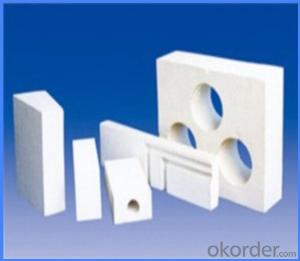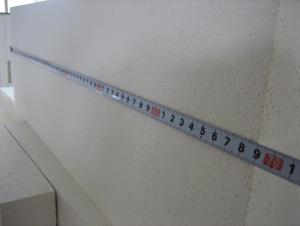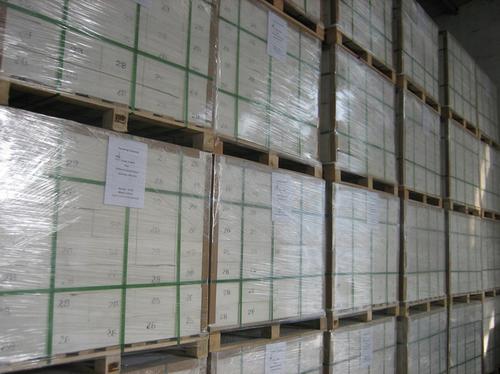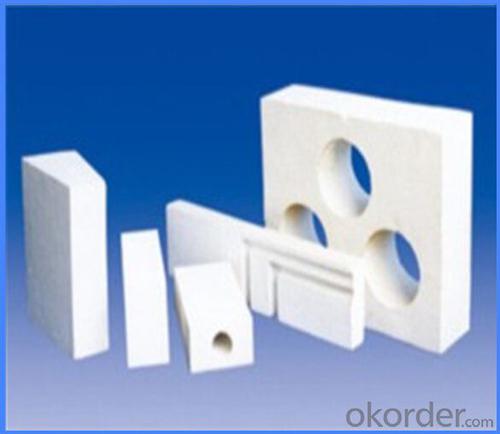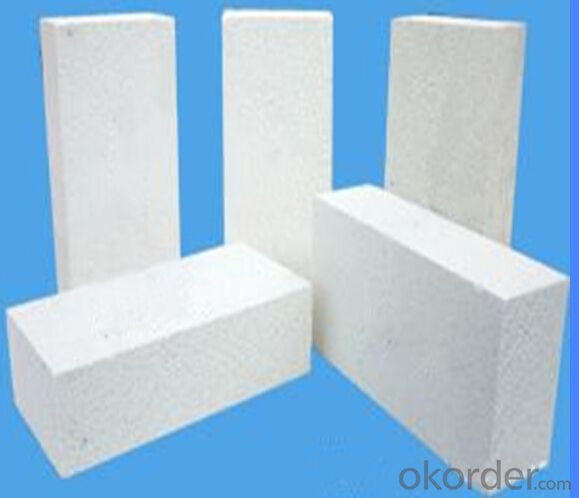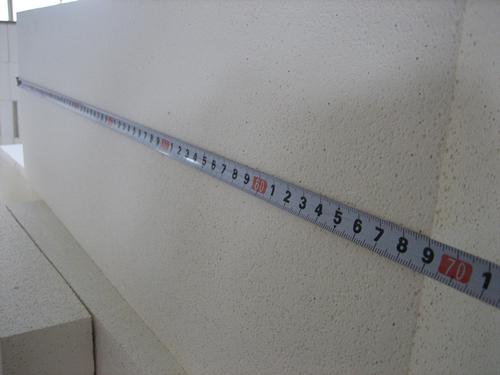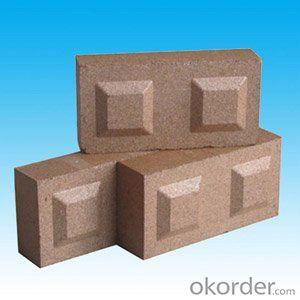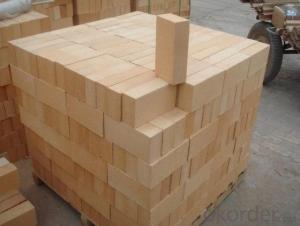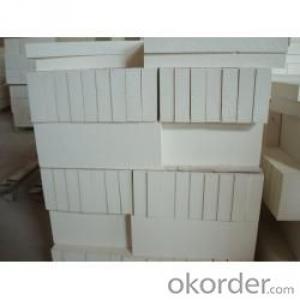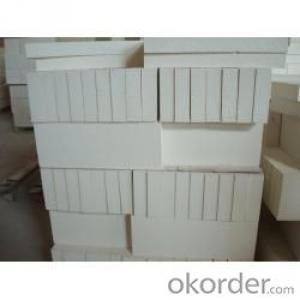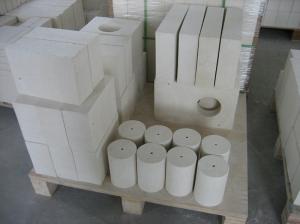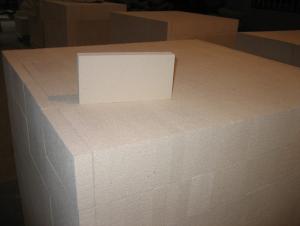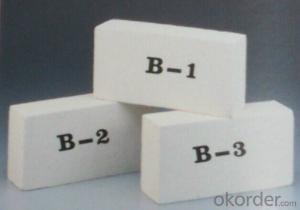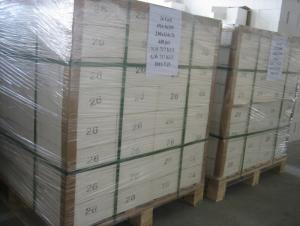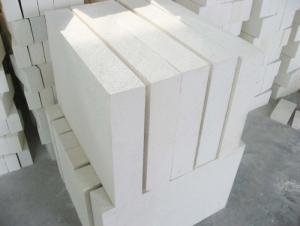Insulating Fire Brick - Refractory Mullite Insulating Refractory Brick JM 33
- Loading Port:
- Shanghai
- Payment Terms:
- TT OR LC
- Min Order Qty:
- 20 m.t.
- Supply Capability:
- 20 m.t./month
OKorder Service Pledge
OKorder Financial Service
You Might Also Like
General Information
CMAX insulating firebricks are classified under temperature between 1300℃ to 1700℃, manufactured from high purity alumina clay.
1. Lower content of iron, alkaline and impurities, good high temperature properties.
2. Homogeneous structure, light weight, energy saving because lower heat storage in the furnace during cooling cycles.
3. High strength, good thermal shock resistance under high temperature.
4. Precise sizes due to grinding and shaping after sintering, which meets the requirement of construction.
5. Max service temp: Up to 1730C (3160F)
Feature
Light weight and low thermal conductivity
Low heat storage
Low iron and impurities
High thermal shock resistance
Application of Insulating brick
Metallurgical Industry: blast furnace, hot blast furnace, heating furnace, etc..
Petrochemical Industry: ethylene cracking furnace, hydrogen furnace, the main furnace, heating furnace, etc..
Ceramic industry: roller kiln, kiln, etc..
Glass industry: glass furnace regenerator, etc.
Carbon industry: carbon furnace, etc..
Aluminum electrolysis industry: aluminum reduction cell, etc.
Other industries: tunnel kiln, shuttle kiln, etc.
Advantages of heat insulation brick
Low thermal conductivity: many air holes will bring good thermal insulation effect, energy saving.
High crushing strength: high crushing strength, volume stability.
Low heat storage: small heat storage, absorb more heat, energy-saving effect is obvious.
Technical Data
ITEM | GJM30 | GJM28 | GJM26 | GJM23 |
Classification Temperature, ℉/℃ | 3000/1650 | 2800/1540 | 2600/1430 | 2300/1260 |
Bulk Density,g/cm³ | ≤1.0 | ≤0.9 | ≤0.8 | ≥0.5 |
Reheating Linear Change, % | ≤0.9 (1550℃,12 h) | ≤0.8 (1510℃,12 h) | ≤0.7 (1410℃,12 h) | ≤0.5 (1230℃,12 h) |
Al2O3 Content, % | ≥75 | ≥65 | ≥55 | ≥45 |
Fe2O3 Content, % | ≤0.5 | ≤0.6 | ≤0.7 | ≤1.0 |
Thermal Conductivity: | ||||
800℃, w/m.k | ≤0.39 | ≤0.37 | ≤0.35 | ≤0.18 |
1000℃, w/m.k | ≤0.43 | ≤0.41 | ≤0.39 | ≤0.20 |
1200℃, w/m.k | ≤0.48 | ≤0.46 | ≤0.43 | --- |
Insulating brick
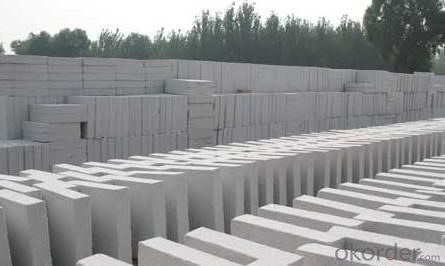
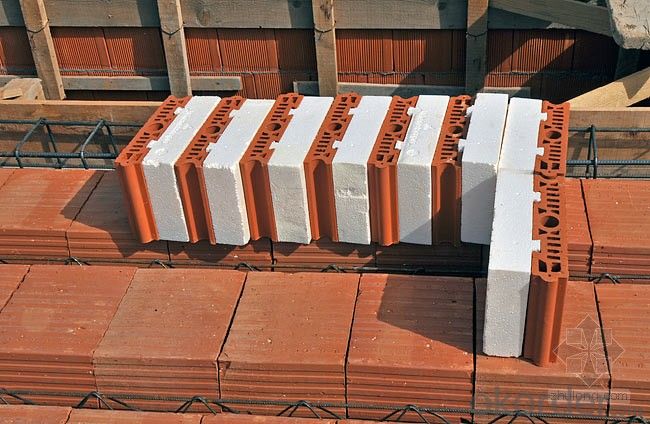
Common problem solution
1. What products do you have?
We have all kinds of refractory bricks, refractory casting materials, mortar, cement, ceramic fiber products, etc..
Or you can browse our products to choose what you need.
2. How to control product quality?
With strict quality control system throughout the material selection and production process, we have the quality of refractory materials and ceramic fiber products to meet customer requirements.
From the selection of raw materials, the quality of our control to start. The quality of the raw materials required for each batch of products in the use of the front line test. In the production process, through the quality control of workers, and then to each piece of classification, and through quality supervision and inspection.
3. Could you give me a brief introduction to the application of your product?
My Company is mainly engaged in steel, cement, glass, ceramics, petrochemical, electric power and other industries.
4. If I need you, what kind of information do you need?
In order to select the right products, we will provide us with information, such as the United States, technical data, order quantity, product applications, etc..
If you have any questions, please contact us.
- Q: How do insulating fire bricks affect the overall insulation efficiency of a process?
- The overall insulation efficiency of a process can be greatly enhanced by the use of insulating fire bricks. These bricks are specifically designed to have low thermal conductivity, making them excellent at resisting heat transfer. This property helps to minimize heat energy loss and maintain a consistent and controlled temperature within the process. The utilization of insulating fire bricks results in a significant reduction in the amount of heat that escapes from the process. This leads to improved energy conservation and ultimately, increased insulation efficiency. The bricks act as a barrier, preventing the conduction of heat through the walls, floors, or other components of the process equipment. This is particularly crucial in high-temperature applications, where heat loss can be substantial. Moreover, insulating fire bricks are capable of withstanding high temperatures without deteriorating or melting. This means that they can effectively insulate the process even when exposed to extreme heat conditions. Their durability ensures long-lasting performance and reliable insulation over time. Another advantage of insulating fire bricks is their lightweight nature. In comparison to traditional dense bricks, they have a lower density, which reduces the overall weight of the equipment or structure. This not only simplifies the construction process but also minimizes the load on supporting structures. In conclusion, insulating fire bricks enhance the overall insulation efficiency of a process by reducing heat loss, maintaining a controlled temperature, and providing long-lasting insulation capabilities. Their low thermal conductivity, resistance to high temperatures, and lightweight properties make them an ideal choice for various industrial applications where energy conservation and efficient insulation are crucial.
- Q: Do insulating fire bricks require any curing or drying time?
- No, insulating fire bricks do not require any curing or drying time. They are ready for use as soon as they are installed.
- Q: What industries commonly use insulating fire bricks?
- Insulating fire bricks are commonly used in various industries where high temperature insulation is required. Some of the industries that commonly use insulating fire bricks include: 1. Steel industry: Insulating fire bricks are used to line the furnaces, kilns, and other high-temperature equipment in steel manufacturing plants. They provide excellent insulation, reducing heat loss and improving energy efficiency. 2. Glass industry: In glass manufacturing facilities, insulating fire bricks are used to line the furnaces and ovens where the glass is melted and molded. These bricks help maintain high temperatures while minimizing heat loss, ensuring efficient and consistent production. 3. Ceramic industry: Insulating fire bricks are used in ceramic kilns and pottery ovens, providing thermal insulation to maintain the desired temperature for clay and ceramic products. They help conserve energy and optimize firing processes. 4. Cement industry: Cement kilns require high-temperature insulation to efficiently produce cement. Insulating fire bricks are used to line the kilns, reducing heat loss and improving thermal efficiency. 5. Foundry industry: Insulating fire bricks are used in foundries to line the melting furnaces and ovens used for metal casting. They help retain heat, ensuring consistent and efficient melting of metals. 6. Power generation industry: Insulating fire bricks are used in boilers, furnaces, and incinerators in power plants. These bricks provide thermal insulation, preventing heat loss and improving the overall efficiency of power generation processes. 7. Petrochemical industry: In refineries and chemical processing plants, insulating fire bricks are used to line equipment such as reactors, furnaces, and ovens. They provide insulation to withstand high temperatures and harsh chemical environments. 8. Pharmaceutical industry: Insulating fire bricks are used in pharmaceutical manufacturing facilities to line the ovens and dryers used for various processes. These bricks ensure precise temperature control and energy efficiency. Overall, insulating fire bricks find applications in industries where high-temperature insulation is crucial for efficient and cost-effective operations.
- Q: Can insulating fire bricks be used in the construction of coke ovens?
- Yes, insulating fire bricks can be used in the construction of coke ovens. Insulating fire bricks are specially designed to withstand high temperatures and provide excellent thermal insulation. Coke ovens operate at extremely high temperatures, typically around 2000 degrees Fahrenheit, and require materials that can withstand these conditions. Insulating fire bricks have low thermal conductivity, which means they can effectively prevent heat transfer between the oven's interior and exterior. This helps to maintain the high temperatures required for the carbonization of coal in the coke oven, while also minimizing heat loss. Furthermore, insulating fire bricks are lightweight and have high strength, making them ideal for use in the construction of coke ovens. Their lightweight nature allows for easier installation and reduces the overall weight of the structure. Their high strength ensures that they can withstand the harsh operating conditions of the coke oven without cracking or crumbling. In summary, insulating fire bricks are a suitable choice for the construction of coke ovens due to their ability to withstand high temperatures, provide thermal insulation, and offer durability.
- Q: Can insulating fire bricks be used in chemical processing plants?
- Indeed, chemical processing plants can utilize insulating fire bricks. These bricks are specifically engineered to endure elevated temperatures and offer exceptional thermal insulation. Consequently, they are suitable for a wide range of industrial applications, including chemical processing plants. They can be employed to line furnaces, kilns, reactors, and other apparatuses where high temperatures are involved. The exceptional thermal insulation properties of insulating fire bricks aid in reducing heat loss, enhancing energy efficiency, and maintaining a steady temperature within the processing equipment. Furthermore, these bricks exhibit resistance to chemical corrosion and can withstand the rigorous conditions typically encountered in chemical processing plants. Ultimately, insulating fire bricks serve as a dependable and efficient choice for insulating and safeguarding equipment in chemical processing plants.
- Q: Do insulating fire bricks require a protective coating for outdoor use?
- Insulating fire bricks have been specifically engineered to endure high temperatures and offer thermal insulation. While they are commonly applied indoors, such as in kilns, furnaces, and fireplaces, they can also be utilized outside. However, the necessity of a protective coating for outdoor use relies on the specific circumstances and environment in which they will be employed. Generally, insulating fire bricks are composed of materials like clay or alumina silicate, which possess inherent resistance to weathering and environmental factors. They can tolerate exposure to rain, snow, and even extreme temperatures without significant deterioration. These bricks are often classified as refractory materials due to their heat resistance, rendering them highly durable in outdoor settings. Nonetheless, there may be instances where it is advisable to apply a protective coating to the insulating fire bricks for additional protection. For example, if the bricks will be continually exposed to harsh weather conditions, prolonged UV radiation, or corrosive substances, a protective coating can enhance their longevity. The selection of coating will depend on the specific requirements and anticipated conditions. Various options are available, such as high-temperature paint, ceramic coatings, or silicone-based sealants. These coatings can furnish an additional layer of safeguarding against moisture, chemicals, and temperature fluctuations, ensuring the bricks retain their insulation properties and structural integrity over time. In conclusion, insulating fire bricks are generally suitable for outdoor use without necessitating a protective coating, as they are specifically designed to withstand high temperatures and adverse weather conditions. However, if the bricks will be exposed to particularly harsh or corrosive environments, applying an appropriate protective coating can offer additional durability and ensure their longevity. It is always recommended to seek guidance from experts or manufacturers for specific advice based on the intended use and outdoor conditions.
- Q: Can insulating fire bricks be used in the construction of hearths?
- Indeed, hearths can be constructed using insulating fire bricks. These bricks are specifically engineered to endure extreme temperatures, rendering them a superb selection for hearth construction. With their low thermal conductivity, they effectively retain heat and hinder the transmission of heat to nearby surroundings. Consequently, they are perfect for establishing a well-insulated and efficient hearth. Furthermore, their lightweight and manageable nature make them highly convenient for construction tasks. All in all, insulating fire bricks prove to be a dependable and pragmatic choice for the development of hearths.
- Q: Can insulating fire bricks be used in the construction of ceramic fiber kilns?
- In the construction of ceramic fiber kilns, insulating fire bricks can indeed be utilized. These bricks are specifically designed to offer thermal insulation and minimize heat loss in high-temperature situations. Their exceptional insulating properties, characterized by low thermal conductivity, render them extremely suitable for maintaining elevated temperatures in kilns. The incorporation of insulating fire bricks in ceramic fiber kiln construction has the potential to heighten the kiln's overall energy efficiency and enhance its performance. However, it is crucial to guarantee that the insulating fire bricks selected align with the particular requirements and operating conditions of the ceramic fiber kiln to achieve optimal outcomes.
- Q: Can insulating fire bricks be cut or shaped to fit specific applications?
- Yes, insulating fire bricks can be cut or shaped to fit specific applications. Insulating fire bricks are made from lightweight refractory materials, typically ceramic fibers or lightweight aggregates, which allows them to be easily cut or shaped without compromising their structural integrity. They can be cut with a saw, knife, or other cutting tools to fit specific dimensions or shapes required for various applications, such as lining kilns, furnaces, or fireplaces. Additionally, insulating fire bricks can be shaped by using molds or by hand molding during the manufacturing process. This flexibility in cutting and shaping makes insulating fire bricks highly versatile and suitable for a wide range of industrial and residential applications.
- Q: Do insulating fire bricks require a specific curing or drying process before use?
- Yes, insulating fire bricks typically require a specific curing or drying process before use. This involves gradually heating the bricks to remove any moisture or volatile materials present, which helps to prevent cracking or damage during subsequent use. The exact curing or drying process may vary depending on the specific type and manufacturer of the insulating fire bricks.
Send your message to us
Insulating Fire Brick - Refractory Mullite Insulating Refractory Brick JM 33
- Loading Port:
- Shanghai
- Payment Terms:
- TT OR LC
- Min Order Qty:
- 20 m.t.
- Supply Capability:
- 20 m.t./month
OKorder Service Pledge
OKorder Financial Service
Similar products
Hot products
Hot Searches
Related keywords

